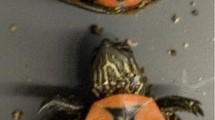Abstract
Red coloration is a conspicuous feature of many visual signals and can function to attract or deter its viewers. Among fishes, red is associated with specialized nuptial, territorial and aposematic (warning) displays. Both sexes of the firemouth cichlid fish Thorichthys meeki develop red ventral coloration at sexual maturity, along with temporally variable black (melanic) elements. Isolated adult firemouth cichlids sequentially presented paired dummy and paired video conspecifics, both with and without red ventral coloration. Subjects interacted more with red-containing stimuli, but with a significant interaction: dummy presentations revealed a strong, positive red bias that video presentations did not. In addition, the melanic color pattern displayed by subjects at the initiation of each trial had a significant effect on subject responsiveness. These results reveal the potential for between-subject differences and experimental design parameters to interact critically in the study of animal color patterns.






Similar content being viewed by others
References
Amundsen T, Forsgren E (2001) Male mate choice selects for female coloration in a fish. Proc Natl Acad Sci U S A 98:13155–13160
Baerends GP, Baerends-van Roon J (1950) An introduction to the study of the ethology of cichlid fishes. Behav Suppl 1:1–242
Baldauf SA, Kullmann H, Thunken T, Winter S, Bakker TCM (2009) Computer animation as a tool to study preferences in the cichlid Pelvicachromis taeniatus. J Fish Biol 75:738–746
Barks PM, Godin J-G (2013) Can convict cichlids (Amatitlania siquia) socially learn the degree of predation risk associated with novel visual cues in their environment? PLoS ONE: e0075858
Barlow GW, Siri P (1994) Polychromatic midas cichlids respond to dummy opponents: color contrast and context. Behaviour 130:77–112
Baube CL (1997) Manipulations of signaling environment affect male competitiveness success in three-spined sticklebacks. Anim Behav 53:819–833
Beeching SC (1995) Colour pattern and inhibition of aggression in the cichlid fish Astronotus ocellatus. J Fish Biol 47:50-58
Bolyard KJ, Rowland WJ (1996) Context-dependent response to red coloration in stickleback. Anim Behav 52:923–926
Couldridge VCK, Alexander GJ (2002) Color patterns and species recognition in four closely related species of Lake Malawi cichlid. Behav Ecol 13:59–64
Cuthill IC, Hart NS, Partridge JC, Bennett ATD, Hunt S, Church SC (2000) Avian colour vision and avian video playback experiments. Acta Ethol 3:29–37
D’Eath RB (1998) Can video images imitate real stimuli in animal behavior experiments? Biol Rev 73:267–292
Dijkstra PD, Hekman R, Shulz RW, Groothuis TGG (2007) Social stimulation, nuptial colouration, androgens and immunocompetence in a sexual dimorphic cichlid fish. Behav Ecol Sociobiol 61:599–609
Egger B, Klaefiger Y, Theis A, Salzburger W (2011) A sensory bias has triggered the evolution of egg-spots in cichlid fishes. PLoS ONE:e0025601
Evans MR, Norris K (1996) The importance of carotenoids in signaling during aggressive interactions between male firemouth cichlids (Cichlasoma meeki). Behav Ecol 7:1–6
Fernald R (1980) Response of male cichlid fish Haplochromis burtoni reared in isolation to models of conspecifics. Z Tierpsychol 54:85–93
Fleishman LJ, McClintock WJ, D’Eath RB, Brainards DH, Endler JA (1998) Colour perception and the use of video playback experiments in animal behavior. Anim Behav 56:1053–1040
Fleishman LJ, Endler JA (2000) Some comments on visual perception and the use of video playback in animal behavior studies. Acta Ethol 3:15–27
Foote CJ, Brown GS, Hawryshyn CW (2004) Female colour and male choice in sockeye salmon: implications for the phenotypic convergence of anadromous and nonanadromous morphs. Anim Behav 67:69–83
Guindre-Parkera S, Gilchrist HG, Baldoa S, Douceta SM, Lovea OP (2013) Multiple achromatic plumage ornaments signal to multiple receivers. Behav Ecol 24:672–682
Hasse JJ (1981) Characters synonymy and distribution of the middle American cichlid fish Cichlasoma meeki. Copeia 1981:210–212
Kodric-Brown A (1989) Dietary carotenoids and male mating success in the guppy: an environmental component to female choice. Behav Ecol Sociobiol 25:393–401
Kodric-Brown A (1998) Sexual dichromatism and temporary color changes in the reproduction of fishes. Integr Comp Biol 38:70–81
Kraak SB, Bakker TCM (1998) Mutual mate choice in sticklebacks: attractive males choose big females which lay big eggs. Anim Behav 56:859–866
Mann ME, Sefc KM (2013) Colour variation in cichlid fish: Developmental mechanisms selective pressures and evolutionary consequences. Semin Cell Dev Biol 24:516–528
Massaro M, Davis LS, Darby JT (2003) Carotenoid-derived ornaments reflect parental quality in male and female yellow-eyed penguins (Megadyptes antipodes) Behav Ecol Sociobiol 55:169–175
Morris MR, Tudor MS, Dubois NS (2007) Sexually selected signal attracted females before deterring aggression in rival males. Anim Behav 74:1189–1197
Neil SJ (1984a) Field studies of the behavioral ecology and agonistic of Cichlasoma meeki (Pisces Cichlidae). Environ Biol Fishes 10:59–68
Neil SJ (1984b) Color pattern variability and behavioral correlates in the firemouth cichlid Cichlasoma meeki Copeia 1984:534–538
Oliveira RF, Rosenthal GG, Schlupp I, McGregor PK, Cuthill IC, Endler JA, Fleishman LJ, Zeil J, Barata E, Burford F, Gonçalves D, Haley M, Jakobsson S, Jennions MD, Körner KE, Lindström L, Peake T, Pilastro A, Pope DS, Roberts SGB, Rowe C, Smith J, Waas JR (2000) Considerations on the use of video playbacks as visual stimuli: the Lisbon workshop consensus. Acta Ethol 3:61–65
Pelkwijk JJ ter, Tinbergen N (1937) Eine reizbiologische Analyse einiger Verhaltensweisen von Gasterosteus aculeatus L. Z Tierpsychol 1:193–204
Robinson-Wolrath SI (2006) Video playback versus live stimuli for assessing mate choice in a pipefish. Environ Biol Fishes 75:409–414
Rosenthal GG (1999) Using video playback to study sexual communication. Environ Biol Fishes 56:307–16
Rowland WJ (1979) Some methods of making realistic fish dummies for ethological research. Behav Res Methods Instrum 11:564–566
Rowland WJ (1982) The effects of male nuptial coloration on stickleback aggression: a re-examination. Behaviour 80:118–126
Rowland WJ (1995) Do female stickleback care about male courtship vigour? Manipulation of display tempo using video playback. Behaviour 132:951–961
Rowland WJ (1999) Studying visual cues in fish behavior: a review of ethological techniques. Environ Biol Fishes 56:285–305
Sato A, Karino K (2006) Use of digitally modified videos to examine female mate preference for orange spot coloration of males in the guppy Poecilia reticulata. Ichthyol Res 53:398–405
Schlupp I (2000) Are there lessons from negative results in studies using video playback? Acta Ethol 3:9–13
Schweitzer C, Motreuil S, Dechaume-Moncharmont F-X (2015) Coloration reflects behavioural types in the convict cichlid, Amatitlania siquia. Anim Behav 105:201–209
Seehausen O, van Alphen JJM (1998) The effect of male coloration on female mate choice in closely related Lake Victoria cichlids (Haplochromis nyererei complex). Behav Ecol Sociobiol 42:1–8
Seitz A (1943) Die Paarbildung bei einigen Cichliden II. Die Paarbildung bei Hemichromis bimaculatus Gill. Z Tierpsychol 5:74–104
Tarvin KA, Murphy TG (2012) It isn’t always sexy when both are bright and shiny: considering alternatives to sexual selection in elaborate monomorphic species. Ibis 154:439–443
Tinbergen N (1948) Social releasers and the experimental method for their study. Wilson Bull 60:6–51
Trainor BC, Basolo AL (2006) Location, location, location: stripe position effects on female sword preference. Anim Behav 71:135–140
West-Eberhard MJ (1983) Sexual selection social competition and speciation. Q Rev Biol 58:155–183
Witte K, Klink KB (2005) No pre-existing bias in sailfin molly females Poecilia latipinna for a sword in males. Behaviour 142:283–303
Wobbrock JO, Findlater L, Gergle D, Higgins JJ (2011) The aligned rank transform for nonparametric factorial analyses using only ANOVA procedures. Conference on Human Factors in Computing Systems - Proceedings 2011:143–146
Zeil J (2000) Depth cues, behavioural context, and natural illumination: some potential limitations of video playback techniques. Acta Ethol 3:39–48
Acknowledgements
I am grateful to the Slippery Rock University Department of Biology and the SRU Institutional Animal Care and Use Committee (IACUC) for support of this research. G. Andraso, P. Falso, and two anonymous referees provided helpful comments on an early version of this manuscript. This work owes much to the late Dr. William J. Rowland, who taught us to make dummies and encouraged us to ask better questions. This research adheres to Animal Behaviour’s “Guidelines for use of animals in research,” all state and federal regulations, and was approved by the SRU IACUC.
Author information
Authors and Affiliations
Corresponding author
About this article
Cite this article
Beeching, S.C. Investigating the behavioral significance of color pattern in a cichlid fish: firemouths Thorichthys meeki respond differently to color-manipulated video and dummy conspecifics. Ichthyol Res 64, 301–307 (2017). https://doi.org/10.1007/s10228-016-0567-y
Received:
Revised:
Accepted:
Published:
Issue Date:
DOI: https://doi.org/10.1007/s10228-016-0567-y




